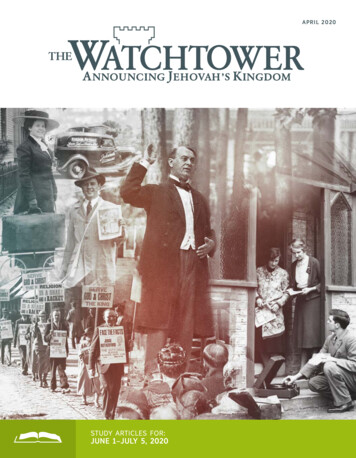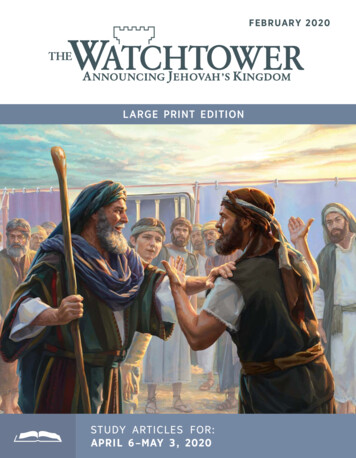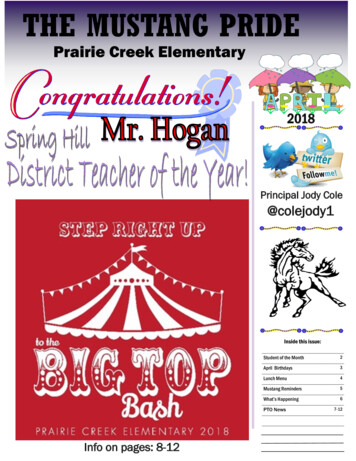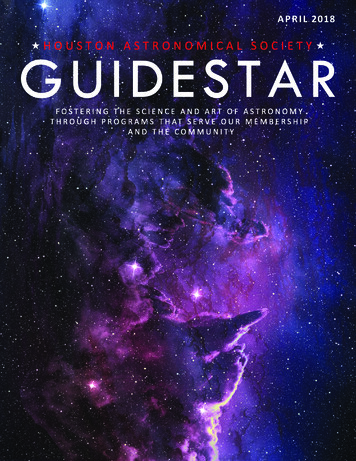
Transcription
APRIL 2 0 2 034567STUDY ARTICLES FOR:JUNE 1–JULY 5, 2020
STUDYARTICLE14An Attack ComingFrom the North!SONG 95The Light Gets BrighterPREVIEWFor many years wehave believed that theprophecy recorded inJoel chapters 1 and 2foretells our modern-daypreaching activity. However, there are four goodreasons why it appearsthat an adjustment shouldbe made in our understanding of this portionof Joel’s prophecy. Whatare those reasons?“A nation has come up into my land.”—JOEL 1:6.MORE than a century ago, Brother C. T. Russell and hisassociates, a small group of other students of God’sWord, began to meet together. They wanted to see if theycould learn what the Bible really teaches about JehovahGod, Jesus Christ, the condition of the dead, and theransom. Their method of study was simple. Someonewould raise a question, and then the group would examine every scripture text related to the subject. Finally,they would make a record of their findings. With Jehovah’s blessing, those sincere Christian men discovered many fundamental Bible truths that we cherish tothis day.2 As those Bible students soon found out, however, itcan be one thing to learn what the Bible teaches about acertain doctrinal subject but quite another to discerncorrectly the meaning of a Bible prophecy. Why is thatso? For one thing, Bible prophecies are often best understood when they are undergoing fulfillment or after theyhave been fulfilled. But there is another factor. To understand a prophecy correctly, we generally have to consider its context. If we focus on only one aspect of theprophecy and ignore the rest, we may draw the wrongconclusion. In hindsight, it seems that this has been thecase with a prophecy in the book of Joel. Let us reviewthat prophecy and discuss why an adjustment in our present understanding is needed.1. What study method was followed by Brother Russell and his associates, and why was it effective?2. What might sometimes lead to wrong conclusions when we aretrying to understand Bible prophecy?2
Read Joel 2:7-9. Joel foretells thata plague of locusts will devastate theland of Israel. With teeth and jaws likethose of lions, the greedy insects will devour everything in sight! (Joel 1:4, 6)For many years, we have applied thatprophecy symbolically to the way inwhich Jehovah’s people, like an unstoppable swarm of locusts, engage in theirpreaching activity. We understood thatthis activity has devastating effects onthe “land,” or the people who are underthe control of the religious leaders.14 If we restricted ourselves to a reading of Joel 2:7-9, a case could be madefor that explanation. However, when weconsider the prophecy in its context, wesee that a different understanding is appropriate. Let us examine four reasonswhy this is so.1 For example, see the article “Jehovah’s Wisdom Observed in Creation” in The Watchtower of April 15, 2009,pars. 14-16.As a second reason, consider whatis written at Joel 2:25. There, Jehovahsays: “I will make compensation to youfor the years that the swarming locust,the unwinged locust, the voracious locust, and the devouring locust have eaten, my great army that I sent amongyou.” Notice that Jehovah promisesto “make compensation” for the damage the locusts have caused. If the locusts picture Kingdom evangelizers, thiswould suggest that the message theyproclaim causes damage. Yet, that lifesaving message can actually move someof the wicked to repent. (Ezek. 33:8, 19)What a blessing that could be for them!7 Read Joel 2:28, 29. Consider a thirdreason—the sequence of events outlinedby the prophecy. Did you notice that Jehovah says: “After that I will pour outmy spirit”; that is, after the locusts havecompleted their assigned task? If the locusts are preachers of God’s Kingdom,why would Jehovah pour out his spirit on them after they finish their witnessing? The reality is that without thehelp of God’s powerful holy spirit, theycould never have kept preaching for decades despite opposition and even banson their work.8 Read Revelation 9:1-11. Now let uslook at the fourth reason. We previously connected the plague of locusts described by Joel with our preaching workbecause of a similar prophecy foundin the book of Revelation. This prophecy describes a swarm of locusts that3-4. Until now, how have we applied the prophecyfound at Joel 2:7-9?5-6. What question arises from a consideration of(a) Joel 2:20? (b) Joel 2:25?7. At Joel 2:28, 29, what is the significance of thewords “after that”?8. Whom do the locusts described at Revelation 9:1-11 represent? (See cover picture.)3FOUR REASONS FOR AN ADJUSTMENTFirst of all, notice Jehovah’s promisewith regard to the plague of locusts: “Iwill drive the northerner [the locusts] faraway from you.” (Joel 2:20) If the locusts represent Jehovah’s Witnesses asthey obey Jesus’ command to preachand make disciples, why would Jehovahpromise to drive them away? (Ezek. 33:7-9; Matt. 28:19, 20) Clearly, Jehovah isdriving away, not his faithful servants,but something or someone who is hostileto his people.56APRIL 20203
PropheciesAbout Locusts—Similar ButDifferentJoel 1:4; 2:7-9, 20Revelation 9:1-11 They come from the north They come out of an abyss They devastate the vegetation They are not to harm the vegetation They are driven away They finish their work They represent the Babylonian armythat invaded Jerusalem in 607 B.C.E. They represent Jehovah’s anointedservants, who boldly proclaim hisjudgmentshave human faces and ‘what seem to becrowns of gold’ on their heads. (Rev. 9:7)They torment “those people [God’s enemies] who do not have the seal of Godon their foreheads” for a period of fivemonths, the average life span of a locust.(Rev. 9:4, 5) This does indeed appearto be a description of Jehovah’s anointed servants. They boldly proclaim God’sjudgments against this wicked system ofthings and, as a result, make its supporters very uncomfortable.9 Admittedly, there are similarities between the prophecy in Revelation and9. What significant differences are there betweenthe locusts Joel saw and those described by John?4THE WATCHTOWERthe one Joel recorded. However, thereare significant differences. Consider: InJoel’s prophecy, the locusts devastatethe vegetation. (Joel 1:4, 6, 7) In John’svision, the locusts are “told not to harmthe vegetation of the earth.” (Rev. 9:4)The locusts Joel saw came from thenorth. (Joel 2:20) Those John saw cameout of an abyss. (Rev. 9:2, 3) The locusts Joel described are driven away.In Revelation, the locusts are not driven away but are allowed to finish theirwork. There is no indication that theydeserve Jehovah’s disapproval.—See thebox “Prophecies About Locusts—Similar But Different.”
The significant differences betweenthe two prophecies lead us to concludethat they are not connected. Are we saying that the locusts described by Joel arenot the same as the locusts presented inthe book of Revelation? Yes. In the Bible, it is not unusual for a symbol toconvey different meanings in differentsettings. For example, at Revelation 5:5,Jesus is called “the Lion of the tribeof Judah,” whereas at 1 Peter 5:8, theDevil is described as “a roaring lion.” Inview of the questions raised by our present understanding, we need to look foranother explanation of Joel’s prophecy.What could it be?10WHAT DOES IT MEAN?A closer look at Joel’s prophecy in itscontext reveals that the prophet was predicting a military attack. (Joel 1:6; 2:1,8, 11) Jehovah said that he would usehis “great army” (Babylonian soldiers)to punish the disobedient Israelites.(Joel 2:25) The invading army is rightly called “the northerner” because theBabylonians would invade Israel fromthe north. (Joel 2:20) That army is likened to a well-organized swarm of locusts. Of them, Joel says: “Each [soldier] advances in his course. . . . Intothe city they rush, on the wall they run.Onto the houses they climb, through thewindows they enter like a thief.” (Joel 2:8, 9) Can you picture the scene? Thereare soldiers everywhere. There is no1110. Give a Scriptural example showing that the locusts described by Joel and by John can representdifferent things.11. What clues do Joel 1:6 and 2:1, 8, 11 give usabout the identity of the locusts?where to hide. No one can escape thesword of the Babylonians!12 Like locusts, the Babylonians (or,Chaldeans) invaded the city of Jerusalem in 607 B.C.E. The Bible reports:“The king of the Chaldeans, who killedtheir young men with the sword . . . , feltno compassion for young man or virgin,old or infirm. God gave everything intohis hand. He burned down the houseof the true God, tore down the wall ofJerusalem, burned all its fortified towers with fire, and destroyed everything ofvalue.” (2 Chron. 36:17, 19) When theBabylonians were finished with the land,onlookers could only say: “It is a wasteland without man and beast, and it hasbeen handed over to the Chaldeans.”—Jer. 32:43.13 Some 200 years after Joel’s prophecy, Jehovah used Jeremiah to foretellsomething else about this attack. He saidthat a thorough search would be madefor those Israelites who engaged in wicked practices—a search that would leadto their capture. “ ‘Here I am sendingfor many fishermen,’ declares Jehovah,‘and they will fish for them. After that Iwill send for many hunters, and they willhunt them down on every mountain andevery hill and out of the clefts of thecrags. . . . I will repay the full amountdue for their error and their sin.’ ” Neither the oceans nor the forests would beable to conceal the unrepentant Israelites from the Babylonian invaders.—Jer.16:16, 18.12. How was Joel’s prophecy about the locusts fulfilled?13. Explain the meaning of Jeremiah 16:16, 18.APRIL 20205
“I Will Pour OutMy Spirit”On the day of Pentecost 33 C.E., about 3,000men and women got baptized as disciples ofJesus Christ. They immediately began sharingthe truth about Jesus with others. Did Jehovahbless their zealous activity? Without a doubt!“Many thousands” became obedient to theword about the Christ.—Acts 2:41; 21:20.How many thousands had become believers?The Bible does not say, but even by the end ofthe first century, the number of believers musthave been far fewer than 144,000. At thattime, Jehovah was selecting men and womento be heirs of the heavenly Kingdom, but themajority of the anointed have been chosen inmodern times. Still, the remarkable growth inthe first century is proof that Jehovah hadpoured out his spirit on those early disciples.—Acts 2:16-18.Is there evidence that Jehovah has poured outhis spirit on his servants today? Definitely!Consider these facts: According to availablerecords, in 1919 there were fewer than 6,000publishers of the good news worldwide. Evenso, Jehovah blessed the preaching work, andsince 1983 far more than 144,000 people havegot baptized as Jehovah’s Witnesses everyyear! Surely this is evidence that Jehovah hasbeen fulfilling his promise about his servants:“I will pour out my spirit”!—Joel 2:28, 29.RESTORATIONOn a positive note, Joel now bringsnews of restoration. The land will befruitful again. (Joel 2:23-26) Then atsome point in the future, an ample supply of spiritual food will become available. “I will pour out my spirit on everysort of flesh,” says Jehovah, “and yoursons and your daughters will prophesy . . . And even on my male slavesand female slaves I will pour out myspirit.” (Joel 2:28, 29) That outpouring of God’s spirit did not occur assoon as the Israelites were brought backfrom Babylon to their homeland. Rather,it took place centuries later, at Pentecost 33 C.E. How do we know?15 Under inspiration, the apostle Peter applied Joel 2:28, 29 to an amazing event that took place on that dayof Pentecost. About nine o’clock thatmorning, there was a miraculous outpouring of holy spirit that moved thosewho received it to begin speaking “aboutthe magnificent things of God.” (Acts2:11) Under inspiration, Peter usedslightly different wording when quotingJoel’s prophecy. Did you notice whatadjustment he made? (Read Acts 2:16, 17.) Instead of beginning the quotation with the words “after that,” Petersaid: “And in the last days”—in this context, the last days of the Jewish systemof things—God’s spirit would be pouredout “on every sort of flesh.” This indicates that considerable time had passedbefore Joel’s prophecy was fulfilled.1414. When was Joel 2:28, 29 fulfilled?15. According to Acts 2:16, 17, what adjustment tothe text of Joel 2:28 did Peter make, and whatdoes that indicate?6THE WATCHTOWER
It was after that remarkable outpouring of God’s spirit in the first century that the preaching work began togo forward to the greatest extent. Bythe time the apostle Paul wrote his letter to the Colossians, about 61 C.E.,he could describe the good news as being preached “in all creation under heaven.” (Col. 1:23) In Paul’s day, “all creation” meant the world as it was thenknown. With the help of Jehovah’s powerful holy spirit, the preaching work hasexpanded much more in our day—“tothe ends of the earth”!—Acts 13:47; seethe box “I Will Pour Out My Spirit.”16WHAT HAS CHANGED?What has changed? We now havea more accurate understanding of theprophecy found at Joel 2:7-9. Simply1716. What effect did God’s spirit have on thepreaching work in the first century, and whatabout today?17. How has our understanding of Joel’s prophecyabout the locusts changed?put, these verses refer, not to our zealous preaching work, but to the activityof the Babylonian army that invaded Jerusalem in 607 B.C.E.18 What has not changed? Jehovah’speople continue to preach the goodnews everywhere, using every possible avenue to do so. (Matt. 24:14) Nogovernmental restriction can prevent usfrom carrying out the commission topreach. And with Jehovah’s blessing, weare more active than ever, courageouslypreaching the good news of the Kingdom! We humbly continue to look to Jehovah for his guidance in understandingBible prophecy, confident that when thetime is right, he will lead us “into all thetruth”!—John 16:13.18. What has not changed about Jehovah’s people?PICTURE DESCRIPTIONS Page 4: Joel’s prophecy predicted a military attack. The Revelationaccount foretold zealous preaching activity.CAN YOU EXPLAIN? Why may adjustments needto be made in our understanding of Bible prophecy? What does the prophecy atJoel 2:7-9 foretell? Why do you feel that adjustments to our understandingare faith-strengthening?SONG 97Life Depends on God’s Word
STUDYARTICLE15How Do You Viewthe Fields?SONG 64Sharing Joyfullyin the HarvestPREVIEWHow does the way we viewour territory affect the waywe preach and teach? Thisarticle examines how Jesus and the apostle Paulviewed their listeners andhow we can imitate themby considering the beliefs,interests, and potential ofthose we meet.“Lift up your eyes and view the fields, that they are whitefor harvesting.”—JOHN 4:35.JESUS had been traveling through fields, likely of younggreen barley. (John 4:3-6) This crop would be ready tobe harvested in about four months’ time. Jesus saidsomething that must have sounded unusual: “Lift upyour eyes and view the fields, that they are white for harvesting.” (Read John 4:35, 36.) What did he mean?2 Jesus was apparently referring to a figurative harvestof people. Consider what had just happened. AlthoughJews usually had no dealings with Samaritans, Jesus hadpreached to a Samaritan woman—and she had listened!In fact, while Jesus was speaking about fields that were“white for harvesting,” a crowd of Samaritans who hadheard about Jesus from the woman were on their way tolearn more from him. (John 4:9, 39-42) One Bible commentary says about this account: “The eagerness of thepeople . . . showed that they were like grain ready for harvesting.”3 What about the people to whom you preach the goodnews? Do you view them as being like grain that is ripe forharvesting? If so, three things will prove true. First, youwill preach with more urgency. A harvest period is limited; there is no time to waste. Second, you will be happy asyou see people respond to the good news. The Bible says:“People rejoice in the harvesttime.” (Isa. 9:3) And third,1-2. Why might Jesus have said the words found at John 4:35, 36?3. If you view people as Jesus did, how will your preaching benefit?8
you will see each person as a potentialdisciple, so you will adapt your approachto appeal to his or her interests.4 Jesus did not write off the Samaritans, as his followers may have done.Instead, he saw them as potential disciples. We too need to see the peoplein our territory as potential disciples ofChrist. The apostle Paul set an outstanding example for us to follow. What canwe learn from him? In this article, wewill discuss how he (1) knew somethingabout the beliefs of those to whom hepreached, (2) discerned their interests,and (3) saw them as potential disciplesof Jesus.WHAT DO THEY BELIEVE?Paul preached often in Jewish synagogues. In the synagogue in Thessalonica, for example, “for three sabbathshe reasoned with [the Jews] from theScriptures.” (Acts 17:1, 2) Paul likely feltcomfortable in the synagogue. He wasraised as a Jew. (Acts 26:4, 5) Paul could54. What will we learn from the apostle Paul in thisarticle?5. Why could Paul relate to his audience in the synagogue?What should we doif we feel that ourfields are “white forharvesting”?(See paragraph 3)relate to the Jews, so he was able topreach to them with confidence.—Phil.3:4, 5.6 After Paul was forced by persecutors to flee Thessalonica and then Beroea, he arrived in Athens. Once again,“he began to reason in the synagoguewith the Jews and the other people whoworshipped God.” (Acts 17:17) Whilepreaching in the marketplace, however, Paul now had a different audience. Among his listeners were philosophers and other Gentiles who viewedPaul’s message as a “new teaching.”They said to him: “You are introducing some things that are strange to ourears.”—Acts 17:18-20.7 Read Acts 17:22, 23. Paul did notpresent his message to the Gentiles inAthens in the same way that he presented it to the Jews in the synagogue. Paullikely asked himself, ‘What do these people in Athens believe?’ He carefully observed his surroundings and took note6. How were the people in the Athenian marketplace different from those to whom Paul preachedin the synagogue?7. According to Acts 17:22, 23, how did Paul adjust his approach?
Following the apostle Paul’s example,be observant, adapt your presentation,and see people’s potential1(See paragraphs 8, 12, 18)10of people’s religious customs. Next, Paulsearched for common ground betweentheir form of worship and the truthin the Scriptures. “As a Jewish Christian, he realizes that pagan Greeks donot worship the ‘true’ God of Jews andChristians,” says one Bible commentator, “but he tries to show that theGod whom he proclaims is in reality no stranger to the Athenians.” SoPaul was willing to adapt his approach.He told the Athenians that his messagecame from the “Unknown God,” whomthey had been trying to worship. Although the Gentiles were not familiarwith the Scriptures, Paul did not give upon them. Instead, he viewed them as being like grain that is ripe for harvesting,and he adjusted his presentation of thegood news.8 Like Paul, be observant. Look forsigns that indicate what beliefs people inyour territory have. How has the householder decorated his home or vehicle?Does his name, dress, grooming, or evenhis vocabulary indicate what his religionis? Perhaps he has told you directly thathe has his own religion. When that happens to a special pioneer named Flutura,she replies, “I’m here, not to impose mybeliefs on you, but to talk to you aboutthis subject . . . ”What subjects might you discuss witha religious person? Try to find commonground. He may worship only one God,he may recognize Jesus as the Savior ofhumankind, or he may believe that weare living in a time of wickedness thatwill soon end. Based on beliefs you havein common, present the Bible’s messagein a way that is appealing to that person.10 Keep in mind that people may notbelieve everything that their religionteaches. So even after you discern aperson’s religion, try to find out whathe personally believes. “Many now mixphilosophy with their religious beliefs,”says David, a special pioneer in Australia. Donalta, in Albania, says, “Somewe meet say that they belong to a religion, but later they admit that they donot really believe in God.” And a mis-8. (a) How can you discern the religious beliefs ofpeople in your territory? (b) If someone says thathe has his own religion, how might you respond?9. What common ground can you find with a religious person?10. What should we try to do, and why?THE WATCHTOWER9
423sionary brother in Argentina notes thatsome people say that they believe in theTrinity, but they may not actually believe that the Father, the Son, and theholy spirit are one God. “Knowing thatmakes it much easier to find commonground with the person,” he says. So tryto find out what people really believe.Then, like Paul, you can “become allthings to people of all sorts.”—1 Cor. 9:19-23.WHAT ARE THEIR INTERESTS?Read Acts 14:14-17. Paul discernedthe interests of his audience, and thenhe adapted his presentation. For example, the crowd he spoke to in Lystrahad little or no knowledge of the Scriptures. So Paul used arguments that theycould relate to. He spoke of fruitful harvests and the ability to enjoy life. He1111. As recorded at Acts 14:14-17, how did Paul inan appealing way present his message to the people who lived in Lystra?used words and examples that his listeners could readily understand.12 Use insight to discern the interestsof people in your territory and adaptyour presentation. How can you findout what a person is interested in asyou approach him or his home? Onceagain, be observant. Perhaps he is gardening, reading a book, repairing a vehicle, or engaging in some other activity.If appropriate, why not use what he isdoing to engage him in conversation?(John 4:7) Even a person’s clothing maysay something about him—perhaps it indicates his nationality, occupation, orfavorite sports team. “I started a conversation with a 19-year-old man whoseT-shirt depicted a famous singer,” saysGustavo. “I asked him about it, andthe man told me why he identified withthe singer. That conversation led to a12. How can you discern a person’s interests andadapt your presentation?APRIL 202011
Bible study, and now he is one of ourbrothers.”13 When you offer to study the Biblewith someone, make it appealing to him;show him how a study will fill his needs.(John 4:13-15) A sister named Poppy,for example, was invited inside the homeof a woman who showed interest. WhenPoppy saw a certificate on the wall indicating that the woman was a professorwho had studied education, she stressedthat we too educate people by means ofour Bible study program and our meetings. The woman accepted a study, wentto a meeting the next day, and attendeda circuit assembly soon thereafter. Oneyear later, she got baptized. Ask yourself: ‘What are my return visits interested in? Can I describe our Bible studyprogram in a way that they would findappealing?’14 After you start a Bible study, prepareseparately for each study you conduct,having in mind the background and interests of your student. As you prepare,decide what scriptures you will read,what videos you will show, and what illustrations you will use to explain Bible truths. Ask yourself, ‘What will especially appeal to and reach the heart ofthis student?’ (Prov. 16:23) In Albania, awoman who was studying with a pioneernamed Flora stated firmly, “I cannot accept the teaching of the resurrection.”Flora did not force the issue. She relates,“I thought that she must first get to knowthe God who promises the resurrection.”13. How might you offer a Bible study in an appealing way?14. How can you tailor a Bible study to each student?12THE WATCHTOWERFrom that point on, at each study, Flora emphasized Jehovah’s love, wisdom,and power. Later, her student readily putfaith in the resurrection. She is now azealous Witness of Jehovah.SEE THEM AS POTENTIAL DISCIPLESRead Acts 17:16-18. Paul did notgive up on the Athenians, even thoughtheir city was filled with idolatry, sexual immorality, and pagan philosophy;nor did he let their insults discouragehim. Paul himself became a Christian,although he had been “a blasphemerand a persecutor and an insolent man.”(1 Tim. 1:13) Just as Jesus saw the potential in Paul, so Paul saw the potential in the Athenians. And his confidencewas not misplaced.—Acts 9:13-15; 17:34.16 In the first century, people of allbackgrounds became Jesus’ disciples.When Paul wrote to Christians living inthe Grecian city of Corinth, he said thatsome members of that congregation hadat one time been criminals or had livedshockingly immoral lifestyles. And thenhe added: “That is what some of youwere. But you have been washed clean.”(1 Cor. 6:9-11) Would you have seen thatthose people had the potential to changeand become disciples?17 Today, many are willing to make thechanges needed to become disciples ofJesus. In Australia, for example, a special pioneer named Yukina learned thatall sorts of people can respond to the Bi1515. According to Acts 17:16-18, what behaviors inancient Greece troubled Paul, but why did he notgive up on the Athenians?16-17. What shows that people of all backgroundscan become disciples of Christ? Give an example.
ble’s message. Once, at a real estate office, she noticed a tattooed young woman wearing baggy clothes. “I hesitatedfor a moment,” says Yukina, “but then Istarted talking to her. I discovered thatshe was so interested in the Bible thatsome of her tattoos were verses fromthe Psalms!” The woman began studyingand attending the meetings.118 Did Jesus view the fields as beingripe for harvesting because he expected that most people would follow him?Not at all. The Scriptures had foretoldthat relatively few would put faith inhim. (John 12:37, 38) And Jesus hadthe miraculous ability to read hearts.(Matt. 9:4) Still, he focused on thosefew who would believe, and he zealously preached to everyone. How muchmore so should we, who cannot readhearts, resist the tendency to judge aterritory or an individual! Instead, seepeople’s potential. Marc, a missionary in1 The series “The Bible Changes Lives” provides moreexamples of how people can change. This series appeared in The Watchtower until 2017. It now continues tobe published on jw.org . Look under ABOUT US EXPERIENCES.18. Why should we not judge people?Burkina Faso, puts it this way: “The people I think will make progress often stopstudying. But the people I think won’t gofar progress very well. So I have learnedthat it is better to let Jehovah’s spiritlead us.”19 At first glance, it may appear thatthere are not many in the territory whoare like grain that is ripe for harvesting.But remember what Jesus said to his disciples. The fields are white, that is, theyare ready to be harvested. People canchange and become disciples of Christ.Jehovah views these potential disciplesas “precious things.” (Hag. 2:7) If we seepeople as Jehovah and Jesus do, we willlearn about their backgrounds and interests. We will view them, not as strangers,but as potential brothers and sisters.19. How should we view people in our territory?PICTURE DESCRIPTION Pages 10-11: As a couplework from door to door in the ministry, theyobserve (1) a well-kept home, decorated withflowers; (2) a home where a young family lives;(3) a home that is unkempt inside and out; and(4) a religious household. Where will you find theperson with the most potential?HOW CAN YOU IMITATE THE WAY PAUL . . . adapted his message tothe religious beliefs of hislisteners? appealed to the interestsof his listeners? saw the potential in thoseto whom he preached?SONG 57Preaching to All Sorts of People
STUDYARTICLE16Listen, Learn, andShow CompassionSONG 101Working Together in UnityPREVIEWAs imperfect humans, wehave a tendency to makequick assumptions aboutpeople and their motives.Jehovah, on the otherhand, “sees into theheart.” (1 Sam. 16:7) Thisarticle will discuss how helovingly helped Jonah,Elijah, Hagar, and Lot. Andit will help us to imitate Jehovah in the way we dealwith our brothers andsisters.“Stop judging by the outward appearance, but judge withrighteous judgment.”—JOHN 7:24.WOULD you like people to judge you based on the colorof your skin, the shape of your face, or the size of yourbody? Likely, you would not. How comforting it is toknow, then, that Jehovah does not judge us by what human eyes can see! For example, when Samuel looked atthe sons of Jesse, he did not see what Jehovah saw. Jehovah had told Samuel that one of Jesse’s sons would become king of Israel. But which one? When Samuel sawJesse’s oldest son, Eliab, he said: “Surely here before Jehovah stands his anointed one.” Eliab looked like a king.“But Jehovah said to Samuel: ‘Do not pay attention tohis appearance and how tall he is, for I have rejectedhim.’ ” The lesson? Jehovah continued: “Man sees whatappears to the eyes, but Jehovah sees into the heart.”—1 Sam. 16:1, 6, 7.2 As imperfect humans, all of us have a tendency tojudge others by their outward appearance. (Read John7:24.) But we learn only a little about a person from whatwe see with our eyes. To illustrate, even a brilliant and experienced doctor can learn only so much by just lookingat a patient. He must listen attentively if he is to learnabout the patient’s medical history, his emotional makeup, or any symptoms he is having. The doctor may evenorder an X-ray to see the inside of the patient’s body.Otherwise, the doctor could misdiagnose the problem.Similarly, we cannot fully understand our brothers andsisters by simply looking at their outward appearance.1. The Bible reveals what comforting truth about Jehovah?2. As indicated at John 7:24, why should we not judge a person by hisappearance? Illustrate.14
We must try to look beneath the surface—at the inner person. Of course, we cannot read hearts, so we will never understand others as well as Jehovah does.But we can do our best to imitate Jehovah.
MORE than a centuryago, Brother C.T. Russell and his associates, a small group of other students of God's Word,begantomeettogether.Theywantedtoseeifthey could learn whatthe Bible really teaches about Jehovah God, Jesus Christ, the condition of the dead, and the ransom. Their method of study was simple.










